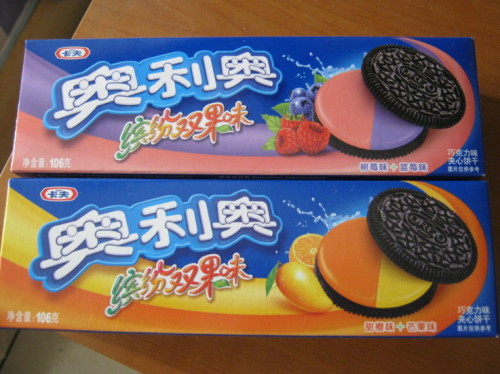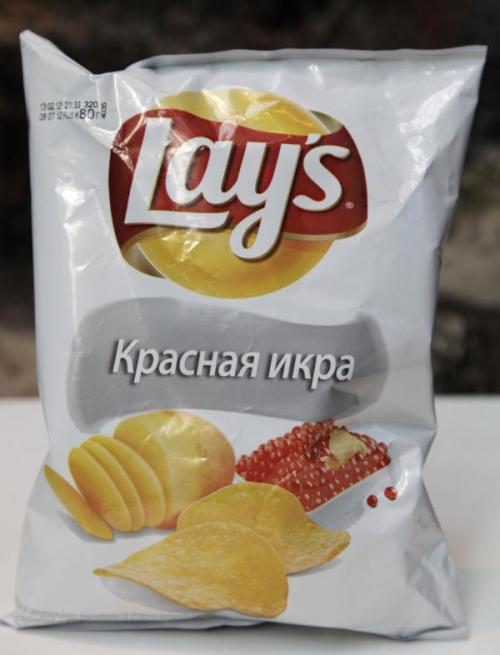Russians prefer their Lay's potato chips dusted in caviar and crab flavors. The Chinese like their Oreos stuffed with mango and orange cream. And in Spain, Kellogg's All-Bran cereal is served floating in hot coffee instead of cold milk.
Americans might get squeamish at the thought of their favorite snacks being tweaked. But what works in the U.S. doesn't always work everywhere.
In other words, Lee Linthicum, a market researcher, says: ``It can't be some generic mix of spices that might fool an American.''
Food makers long have tinkered with their products to appeal to regional tastes, but getting the recipe just right is becoming more important than ever. That's partly because people in emerging nations such as China and India are gaining more of an appetite for American-style ``on-the-go'' foods as they work longer hours and have less time to cook. But it's mostly because snack makers increasingly are looking for growth in other parts of the world as sales slow in the U.S.
Growth in the snack food industry has been virtually flat in the U.S. for the past two years, according to market research firm Euromonitor. Meanwhile, combined sales in China, Brazil and Russia _ three major developing markets _ rose 15 percent in 2010 and 11 percent last year to $17 billion. That's half the size of the U.S. market but it's growing.
The challenge for snack makers is that people in other countries have different tastes. Consider the Oreo, which Kraft Food Inc. introduced in China in 1996. Sales of the vanilla cream-filled chocolate cookie sandwich were respectable there, but the Chinese didn't completely take to it.

So Kraft decided to tweak the Oreo. But executives of the Northfield, Illinois-based company knew that they had to proceed with caution. ``When you have a brand that's 100 years old, you don't mess with the recipe thoughtlessly,'' says Lorna Davis, head of the company's global biscuit and cookies business.
In 2006, Kraft began offering the Oreo as a wafer, a popular cookie throughout Asia. It is made up of cream sandwiched between crispy wafers. The plan was to help familiarize more Chinese customers with the brand. Three years later, the company decided to go a step further.
Kraft worked with a panel of consumer taste experts from around the world to identify the characteristics of the Oreo _ including color, crunchiness, bitterness, color _ that were likely to appeal to Chinese tastes. Executives learned through research that the Chinese don't like their treats as big or as sweet as Americans do. So the company rejiggered the recipe to create a cookie that was a tad smaller and a touch less sweet.
To test the new recipe, hundreds of Chinese consumers tasted the new Oreo. It was a hit. ``It made us realize the smallest of details make a big difference,'' Davis says.
But the company wasn't finished. After noticing sales of Oreos were lagging in China during the summer, Kraft added a green tea ice cream flavor. The cookie combined a popular local flavor with the cooling imagery of ice cream. The green tea version sold well, and a year later, Kraft rolled out Oreos in flavors that are popular in Asians desserts _ raspberry-and-blueberry and mango-and-orange.
The result? Over the past five years, Kraft said sales have grown an average of 60 percent a year, although it declined to give revenue amounts. The Oreo now is the top-selling cookie in China with a market share of 13 percent. The previous top cookie was a biscuit by a Chinese company.
Kraft, which operates in more than 80 countries, is taking a similar approach with other snacks. In Saudi Arabia, Kraft offers its Tang powder drink in a lemon-pepper flavor. In Mexico, it comes in tropical fruit flavors like tamarind and mandarin, and a hibiscus version fashioned after the flower. Sales have nearly doubled to $1 billion worldwide since Kraft rolled out the localized versions in 2006.
Kraft's ability to adapt to local tastes is increasingly important as it looks for growth overseas. The rise in international revenue at Kraft was more than double the increase in North America last year.
Kraft also plans to split into two separate units by the end of the year. The largest will be a global snacks company called Mondelez International, pronounced ``mohn-dah-leez,'' to sell its Trident gum and Cadbury chocolates in fast-growing countries worldwide.
Kellogg Co., the world's largest cereal maker, also has intensified its focus on catering to local tastes as it attempts to grow its business overseas.
Last year, the company's revenue in Latin America topped $1 billion for the first time. And in February, Kellogg said it had agreed to buy the Pringles chip brand from Procter & Gamble for $2.7 billion. The deal will nearly triple its international snack business, making it the world's second-largest snack maker behind PepsiCo Inc.
The company, based in Battle Creek, Michigan, already sells products in more than 180 countries. It's learning that on-the-ground insights can pay off. In Europe, for instance, Kellogg for many years had marketed its cereals there just as it did in the U.S. But it failed to take into account that many in the region don't drink cold milk in the morning.
Now, an American traveling in Spain might find it surreal to see TV ads showing All-Bran cereal floating in a steaming cup of coffee. Kellogg, which makes Keebler, Cheez-It and Kashi bars, declined to give details on how well the cereal is selling there, but it said the marketing has resulted in ``great results.''
A similar story played out for PepsiCo. For the first time last year, revenue from the company's international snacks division surpassed revenue in North America. To achieve that, PepsiCo has had to adjust its recipes.

In 2005, PepsiCo's food division began a quest to make its Lay's potato chips more appealing to local tastes in Russia. It wasn't easy. Russians still like packaged versions of a Soviet-era snack _ stale bread slathered in oil and baked to a crisp.
``Potato chips were not big in the Communist time, so it's something we're gradually building,'' says Marc Schroeder, who heads PepsiCo's food division in Russia.
To get a better sense of what Russians like, employees traveled around the country to visit people in their homes and talk about what they eat day-to-day. That was a big task. Russia has nine time zones and spans 7,000 miles (11,000 kilometers), with eating habits that vary by region.
The findings were invaluable for executives at the company's Purchase, New York, headquarters. In the eastern part of the country, PepsiCo found that fish is a big part of the diet. So it introduced ``Crab'' chips in 2006. It's now the third most popular flavor in the country.
A ``Red Caviar'' flavor does best in Moscow, where caviar is particularly popular. ``Pickled Cucumber,'' which piggybacks off of a traditional appetizer throughout Russia, was introduced last year and is already the fourth most popular flavor. Other favorites include onion, bacon and ``sour cream and herbs,'' which is a bit sweeter than the American version.
The chip translations are paying off; sales of Lay's have more than doubled in the past five years. As for the classic Lay's _ an American favorite _ Russians still aren't biting.
``They find it a very boring flavor,'' Schroeder said.
나라별 인기있는 과자 맛 따로 있다?
러시아인들은 캐비어와 게맛 레이스 감자칩을 선호하고, 중국인들은 오렌지와 망고 크림이 들어있는 오레오 쿠키를 즐겨 찾는다. 또 스페인에서는 켈로그의 씨리얼을 차가운 우유가 아닌 뜨거운 커피에 넣어 먹는다.
펩시코 계열의 과자 제조회사인 프리토 레이스사와 오레오를 만드는 크래프트 푸즈(Craft Food’s)의 그리고 켈로그사(Kellogue’s)는 모두 미국 기업으로 미국인의 입맛에 맞는 스낵을 그대로 외국에 수출하다가 참패를 겪고 새로운 전략을 펴 판매율을 높인 기업이다.
이 기업들이 해외시장 진출에 박차를 가하는 이유는 지난 2년간 미국의 스낵시장이 고전을 면치 못했으며 중국과 인도와 같은 개발 도상국들의 부상으로 근무시간이 길어져 요리할 시간이 줄어든 이들에게 미국 스타일의 손쉽게 먹을 수 있는 식품이 각광을 받기 시작했기 때문이다.
중국, 브라질, 러시아 3국의 판매이익의 합계는 지난 2010년엔 15% 상승했고, 작년에는 11% 상승해 매출이 170억 달러에 달했다.
크래프트 푸즈는 초코렛 쿠키 사이에 바닐라 크림을 넣어 만든 오레오 쿠키를 1996년 중국에 처음 선보였지만 인기몰이에는 성공하지 못했다.
이에 크래프트는 소비자 패널들을 모집해 과자의 색깔, 씹히는 질감, 쓴맛 등으로 중국인의 선호도를 조사해 중국인들이 미국인처럼 크고 단 음식을 좋아하지 않는 다는 사실을 발견했다.
새로운 조리법으로 만든 쿠키를 실험하기 위해 수백 명의 중국인 소비자와 품평회를 열었고 결과는 대 성공이었다. 크래프트는 또 아시아 디저트로 인기있는 라즈베리와 블루베리 맛, 망고와 오렌지 맛 쿠키도 출시해 큰 인기를 얻었다.
세계 최대 규모의 씨리얼 제조사 켈로그사는 크래프트사와 다른 전략을 썼다.
이미 약 180여국에 과자를 수출하는 켈로그는 한차례의 실패 후 각 수출대상국의 특성에 대한 이해가 수익으로 돌아온다는 것을 인지했다. 한 예로 유럽에서는 아침에 찬 우유를 마시지 않는 다는 것을 고려하지 않고 미국에서의 마케팅을 그대로 적용하여 실패의 요인이 됐다.
켈로그는 차가운 우유대신 뜨거운 커피에 씨리얼을 넣어 먹는 광고를 텔레비젼에 방영한 결과 판매에 좋은 결과를 가져오게 됐다고 밝혔다.
한편, 펩시코는 러시아의 감자칩 시장을 뚫으려 시도했지만 러시아인들은 소련시절의 과자만을 고집할 뿐이었다.
펩시코는 러시아인들의 취향을 조사하기 위해 러시아의 전역과 가정을 방문해 매일 그들이 무엇을 먹는지에 대해 물었다. 넓은 영토만큼 다양한 식생활을 가진 러시아를 분석하는 일은 쉬운일이 아니었다.
생선이 그들의 식단에 큰 부분을 차지한다는 점을 발견한 펩시코는 2006년 게맛 감자칩을 선보였고 레드 캐비어와 오이피클 맛을 차례로 출시해 지난 5년간 레이스 감자칩의 판매율이 두 배 이상 상승하는 결과를 낳았다.



![[Herald Interview] 'Amid aging population, Korea to invite more young professionals from overseas'](http://res.heraldm.com/phpwas/restmb_idxmake.php?idx=644&simg=/content/image/2024/04/24/20240424050844_0.jpg&u=20240424200058)













![[KH Explains] Korean shipbuilding stocks rally: Real growth or bubble?](http://res.heraldm.com/phpwas/restmb_idxmake.php?idx=652&simg=/content/image/2024/04/25/20240425050656_0.jpg&u=)

